Review Article - (2024) Volume 2, Issue 5
Regenerative Medicine
Received Date: Oct 15, 2024 / Accepted Date: Nov 20, 2024 / Published Date: Dec 16, 2024
Copyright: ©2024 Shahir Dhunraj Dukhan. This is an open-access article distributed under the terms of the Creative Commons Attribution License, which permits unrestricted use, distribution, and reproduction in any medium, provided the original author and source are credited.
Citation: Dukhan, S. D. (2024). Regenerative Medicine. Eng OA, 2(5), 01-05.
Abstract
Nanotechnology has made inroads into the field of regenerative medicine. The most recent is nanofiber technology which is developed by electrospinning however it is still being proven with experiments. This technology has made it possible for the development of scaffolds whereby cells can now adhere to a substrate. This advancement in tissue engineering can assist in the regeneration of bones, skin heart cornea and other human systems. There has also been experimental research done on rats that be used in the treatment of spinal cord injuries through microfibre technology. Nanotechnology as regenerative cellular technology finds its way in the replacement of cells that have been lost due to diseases such as Alzheimer’s and other illnesses. There is still much to be researched in this emerging field of research. Nanotechnology will become a way of life shortly with humans living disease-free lives [10].
Keywords
Advancement, Alzheimer Development Disease, Electrospinning microfibre, Technology, Nanotechnology, RegenerativeCellular-Technology, Regenerative-Medicine, Scaffolds, Substrates, Tissue- Engineering
Introduction
Humanity faces a multitude of illnesses and diseases worldwide, including Parkinson's disease, Alzheimer's disease, osteoporosis, spinal injuries, and cancer. Regenerative medicine is a form of nanomedicine which harnesses nanotechnology to treat incurable conditions, such as birth defects, organ failure, heart disease, and diabetes. In the past, patients often faced tragic outcomes due to the shortage of organs as they depend on organ donors. The objective of regenerative medicine is to develop nanotechnology-based robots to aid in organ regeneration and perform microsurgeries for heart disorders. Furthermore, the goal is to offer alternative treatments for diabetes and heart disease, ultimately saving lives.
Literature Review
Regenerative medicine uses bioartificial materials as these materials can mimic the original tissue that was lost or damaged in the human body. Before the discovery of bioartificial materials, doctors had to use inert prosthetics, however, scientists have found alternative solutions such as the aforementioned information. Scientists collaborate with biochemists, chemists, metallurgical engineers and biomedical engineers to develop materials that are designed to be safe when they are in contact with tissues in the human body. The material should not cause inflammation, and it should not contaminate the fluids in the body, it must also be adhesive as the cell should be able to regenerate on this bioartificial material. An assured proliferation will subsequently be established, and the cell will be able to form an extracellular matrix without any interference [9]. For regenerative medicine to work, a cell must have the following characteristics: the cell should be able to naturally reorganize and deposit its extracellular matrix, three- dimensional fibrillar adhesions, matrix adhesions as well as a fibronectin matrix must be deposited (This is also dependent on the capability of the material). According to [9], the biological sciences term used to describe a combination of all of these factors is Biocompatibility (This measures the ability of a material to induce cells to regenerate). An important application of nanotechnology is in slow wound healing, which is a common problem in diabetic patients. Diabetic patients are susceptible to bacterial infections when they are injured as they suffer from chronic hyperglycemia. A type of gel developed from nanotechnology accelerated healing in diabetic patients as it was able to regulate angiogenesis as well as local immunity. Trials in rats further confirmed this research as faster healing was observed in diabetic rats. They compared this gel to topical ointments such as petroleum jelly, which is known as Vaseline, and found that the PA-gel they developed was more effective. Their gel contained zinc oxide and cerium oxide which aided in regenerating the endothelial cells and blood vessels within the skin as it produced carbon monoxide. This could prevent diabetic patients from developing diabetic foot which leads to amputation [8]. Figure One illustrates the common complications experienced by people suffering from diabetes. It also shows the types of nanotechnology that have been developed to attempt to treat these disorders [8].
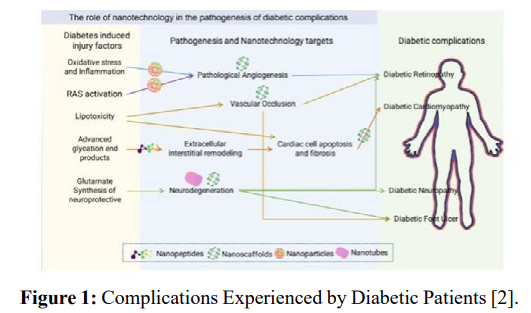
The human body has tissues that do not possess the ability to regenerate when it is damaged or scarred; for example, in the heart and kidneys, the cardiac tissue and the nephrons cannot reconstruct once it is permanently disfigured. Cell sheet engineering is a process of collecting cells in their natural state, detaching them spontaneously and then carefully removing them from a polymer which is temperature sensitive. This is what is known as a thermoresponsive polymer. This polymer must be prepared meticulously as it needs to accept the cell sheets. Figure 3 [7] is an illustration of the process of cell sheet technology and it supports the claims made in this paragraph [7].
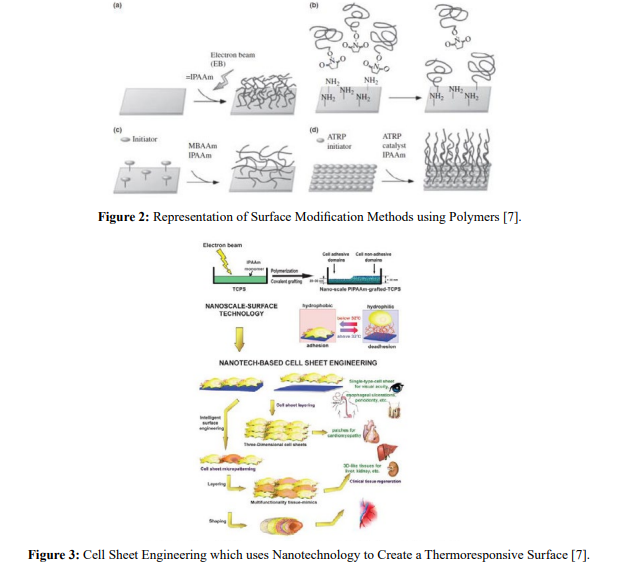
Pluripotent stem cells were induced to drive tissue engineering and support regenerative medicine. They are referred to as iPSCs in the article. This method in nanomedicine requires scaffolds made of nanomaterials that must have the properties mentioned in Article One. The behaviours from article one must also be considered. These iPSCs are genetically programmed to display regenerative properties to become eligible for tissue engineering. However, the manner in which stem cells are extracted poses some ethical issues as they have to be removed from human embryos. The other issue is that rejection could occur when the donor's stem cells are implanted. Lastly, a complicated scaffolding system needs to be created and modified in order for this research to be successful which can require a lot of resources. This can be very costly and time-consuming [10]. According to Sarka Kubinova and Eva Sykova, Nanofibrous materials facilitate the adhesion of cells that are specifically engineered as scaffolds for the skin, bone, heart, cornea, and other tissues. The nanofibers can promote the regeneration of cells that have been lost from diseases such as Alzheimer’s. In experiments involving the spinal cords of rats, nanofiber technology was used to repair the spinal cord. The application is suitable when larger areas or cells are to be repaired or replaced [6]. Research has been rapidly performed in the past to aid the development of nanotechnology and nanomaterials which are related to stem-cell and tissue therapeutic procedures. This uses the principles of physics, biology and engineering to design, synthesise, characterise, and apply knowledge from material sciences as well as robotics. The fundamental ideology of nanoengineered devices is created with certain physical and chemical that are controlled. This effectively combines technology with medicine, anatomy and physiology.
An analysis of regenerative medicine needs to be studied, this includes the biological as well as the physical interaction of cells with the environment. The surrounding environment is composed of nanometer-scale particles which display distinct biological signals. This shall determine the reaction or behaviour of the cell. The state of the cell will also impact the rate of regeneration. The cell must be alive as mitosis (cell division) needs to occur when the nanomaterial acts as a scaffold. The cell behaviour is adjusted for it to divide into new cells [5]. In the past, researchers used nanoparticles in medical drugs and DNA molecules to treat only a specific part of the human body. However, the advancement of nanotechnology allows nanofibers to be used as a scaffolding for tissues and to alter the surface of implantable materials as well as nanodevices like biosensors. Stem Cells can be extracted from embryos, foetal amniotic and umbilical cords. Genetic and degenerative disorders can be treated with these stem cells as their ability to regenerate is enhanced. It can also fix ageing- related conditions that were thought to be incurable [5].
Commercial applications of this technology are already available as microelectromechanical devices can control and optimise the conditions that are necessary for regeneration in cells. Bioreactors have biosensors and chips produced in a laboratory to ensure that this can take place. The stem cells would then be placed with scaffolds in the bioreactor. A tissue matrix will be created, and this will be implanted into a person’s body which will regenerate their cells [5]. The complexity of biological cells was studied which contributed to the research on therapeutic uses of nanotechnology. This research can be applied to medical drug transportation, diagnostic robotic tools, surgical processes, nano-biomaterials, gene therapies and nano-biomedical devices.
Multipotent adult progenitor cells can self-renew, and they are omnipresent in the human body. These cells maintain homeostasis and continuously repair damaged or scarred tissue throughout one’s lifetime. Research on these cells allowed nanotechnology to emerge as Sir Richard Feynmann idealized this technique as he suggested that atoms can be reorganized as long as the laws of physics are not violated. This led to the idea that atoms can be manipulated and their properties can be altered therefore new molecular structures and compounds can be formed using different chemical processes. Nanotechnology is therefore a procedure which synthesises functional structures on a nanometric scale. Devices which have unique physical, chemical and biological characteristics will be formed. The properties that these devices depend on shall also change. This includes the ability of the device to conduct electricity, how the device reacts to the environment, the functional conformation, and the melting temperature. The article [4] suggests that nanotechnology may use this technology to treat osteoarticular diseases, neurological disorders, cardiovascular diseases and cancerous tumours. [4].
Bioengineered materials can regenerate tissues in the human body. These materials have micron scales or larger surface features. Nano topographies can be added to the surface of a biomaterial to enhance the different functions of cells. This is also known as bioinspired nanomaterials as evidence from laboratory experiments proved that titanium implants increased the rate of calcium deposits which allowed the formation of new bone structures. Orthopaedic surgeons use this technology to minimise the complications associated with implants as patients recover quickly from joint replacement procedures [3]. Nanomaterials are directly related to regenerative medicine as the surface structure and molecular nature of a material will determine whether tissues can regenerate or die on this material. There are toxic materials found in nature and this can be harmful to people. This reinforces the claims made by biological science experts which stated that the behaviour of cells depends on the surrounding environment. The physical and chemical properties of a cell can be reengineered to regenerate in areas of the body which is damaged or scarred. These points echo the research that was conducted in [5]. The topography is a crucial aspect as [3] and [10] stated that microtopography will influence cell adhesion, proliferation as well as differentiation [2,9,10]. Therefore, it is evident that nano topography helps scientists understand the behaviour of cells. The cell orientation, adhesive proteins and other growth factors also need to be taken into consideration [2].
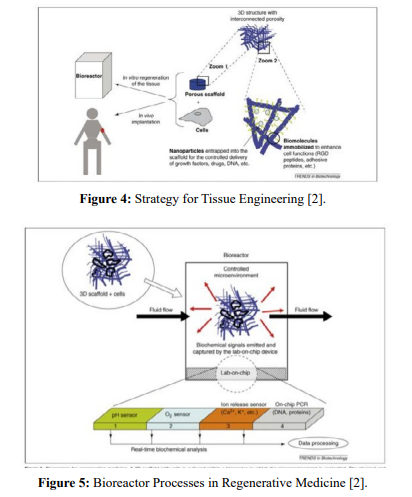
Nanomaterials are required to interact at a molecular level with biological systems. The properties of nanomaterials include optical, structural, magnetic and electronic aspects that can be obtained from either molecules or bulk materials. These materials must be designed in a specific manner to interact with proteins as well as cells however it cannot interfere with their biological activities. The physical properties of nanomaterials have to remain the same after the reaction has taken place. Lastly, it must be non- toxic which supports the points made in article [2] above.
Figure 6 shows the disadvantages of using nanotechnology [1]. The key issues include the fact that it is challenging to monitor the long-term behaviour of transplanted stem cells, it is also a challenge to direct stem cells so that they can migrate to the correct location in the human body. Advanced labelling techniques still need to be developed to track the stem cells that were transplanted. The time intervals between stem cell therapy sessions still need to be determined as more research needs to be conducted on this aspect [1].
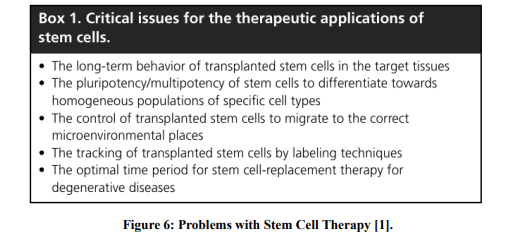
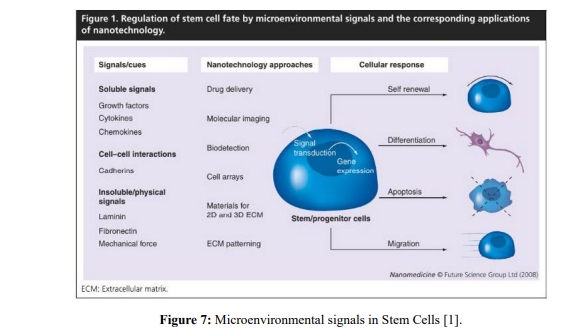
Experimental Parameters and Methodology
From the literature review, the following conclusions can be made to follow a procedure:
• Cells should regenerate when exposed to the correct environmental conditions.
• The extraction of stem cells enables scientists to re- engineer a cell for regeneration.
• The physical and chemical properties of a biomaterial should be capable of altering cell behavior.
• A bioreactor should create a tissue matrix to enable cell regeneration.
• Nano topographies can enhance the functions of cells.
• The cell's state should determine its ability to regenerate.
• Nanomaterials should either be inert or reactive to facilitate cell regeneration.
The initial phase will involve trials on animals, specifically squirrels, rats, and mice suffering from the disorders. Animal organizations will be actively involved to ensure the ethical treatment of the animals throughout the process. Subsequently, an application will be submitted to the HPCSA to seek permission for human trials to occur. Upon approval from the relevant organizations, volunteers with diabetes, heart disease, and organ failure will participate in the human trials. Close monitoring by doctors and health professionals will be in place to ensure the wellbeing of the volunteers.
Results and Discussion
The literature review was conducted to determine whether nanotechnology and regenerative medicine are related to one another. From the literature review, it is evident that nanotechnology can be applied to regenerative medicine therefore the techniques that were examined in different nanotechnologies that were previously developed can be utilized to cure diseases that were once impossible to treat. Organ failure and other illnesses such as diabetes can be treated properly using this form of technology. A bioreactor can use stem cells to create scaffolds in order to enable stem cells to divide in a manner which will create the tissue that was damaged. This is related to tissue engineering and biomedical engineering.
Conclusion
There is a clear link between nanotechnology and regenerative medicine. Regenerative medicine depends on nanotechnology to create the correct conditions for cells to regenerate on nanomaterials which allows a cellular matrix to form and develop on its own. A complex scaffolding system needs to be developed and modified for regenerative medicine to be successful. In essence, all the factors affecting cell division should be taken into account before different techniques of nanomedicine is applied.
References
1. J. D. K. K.-B. L. Solanki Aniruddh, “Nanotechnology for regenerative medicine: nanomaterials for stem cell imaging ,” REVIEW: Future medicine , pp. 567–578, 2008.
2. A. M. M. N. D. L. and J. A. P. Elisabeth Engel, “Nanotechnology in regenerative medicine: the materials side,” Elsevier , vol. 26, no. 1, pp. 39–47, 2007.
3. Dongwoo Khang & Joseph Carpenter & Young Wook Chun & Rajesh Pareta & Thomas J. Webster, “Nanotechnology for regenerative medicine,” Springer Science , pp. 575–587, Dec. 2008.
4. E. J. C. S. Angela Mazzeo1, “Nanotechnology and multipotent adult progenitor cells in Reparative Medicine: therapeutic perspectives,” Einstein, pp. 1–6, Sep. 2018.
5. A. S. a, N. D. a, A. C. a, c, *, G. R. b, A. A. R. b Pooja Arora a, “Nano-regenerative medicine towards clinical outcome of stem cell and tissue engineering in humans,” J. Cell. Mol.Med, vol. 16, no. 9, pp. 1991–2000, Jan. 2012.
6. E. S. Sarka Kubinova, “Nanotechnologies in regenerative medicine ,” Research Gate, Jun. 2010.
7. M. Y. T. O. I. Elloumi-Hannachi, “Cell sheet engineering: a unique nanotechnology for scaffold-free tissue reconstruction with clinical applications in regenerative medicine,” J Intern Med, pp. 54–70, 2009.
8. Y. L. N. W. Danyang Li, “Application progress of nanotechnology in regenerative medicine of diabetes mellitus,” Diabetes Research and Clinical Practice , pp. 1– 8,2022.
9. NATO Science for Peace and Security Series, “Advances in Regenerative Medicine: Role of Nanotechnology, and Engineering Principles,” Series A: Chemistry and Biology, pp. 1–15, Sep. 2007.
10. D. R. Murugan Ramalingam, “Impact of Nanotechnology in Induced Pluripotent Stem Cells-driven Tissue Engineering and Regenerative Medicine,” Journal of Bionanosciences , vol. 9, pp. 13–21, 2015.



